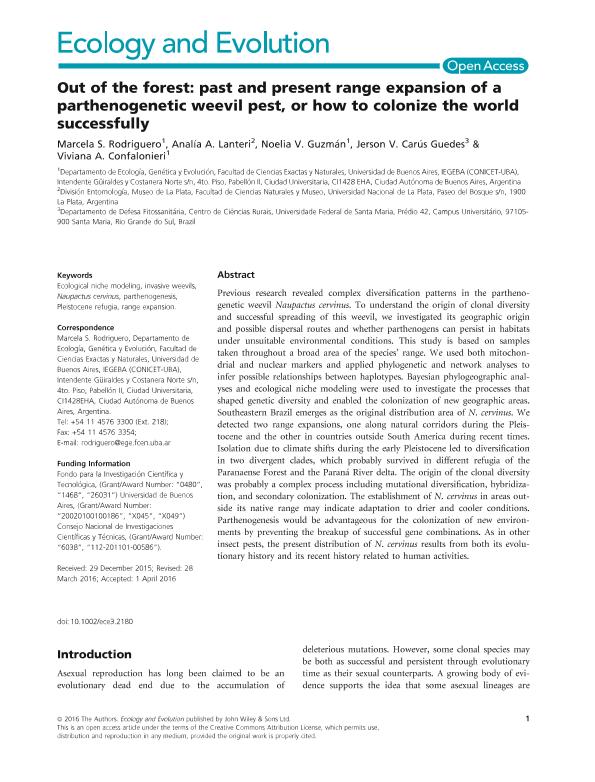Artículo
Out of the forest: past and present range expansion of a parthenogenetic weevil pest, or how to colonize the world successfully
Rodriguero, Marcela Silvina ; Lanteri, Analía Alicia
; Lanteri, Analía Alicia ; Guzman, Noelia Veronica
; Guzman, Noelia Veronica ; Carús Guedes, Jerson V.; Confalonieri, Viviana Andrea
; Carús Guedes, Jerson V.; Confalonieri, Viviana Andrea
 ; Lanteri, Analía Alicia
; Lanteri, Analía Alicia ; Guzman, Noelia Veronica
; Guzman, Noelia Veronica ; Carús Guedes, Jerson V.; Confalonieri, Viviana Andrea
; Carús Guedes, Jerson V.; Confalonieri, Viviana Andrea
Fecha de publicación:
08/2016
Editorial:
John Wiley and Sons Ltd
Revista:
Ecology and Evolution
ISSN:
2045-7758
Idioma:
Inglés
Tipo de recurso:
Artículo publicado
Clasificación temática:
Resumen
Previous research revealed complex diversification patterns in the parthenogenetic weevil Naupactus cervinus. To understand the origin of clonal diversity and successful spreading of this weevil, we investigated its geographic origin and possible dispersal routes and whether parthenogens can persist in habitats under unsuitable environmental conditions. This study is based on samples taken throughout a broad area of the species’ range. We used both mitochondrial and nuclear markers and applied phylogenetic and network analyses to infer possible relationships between haplotypes. Bayesian phylogeographic analyses and ecological niche modeling were used to investigate the processes that shaped genetic diversity and enabled the colonization of new geographic areas. Southeastern Brazil emerges as the original distribution area of N. cervinus. We detected two range expansions, one along natural corridors during the Pleistocene and the other in countries outside South America during recent times. Isolation due to climate shifts during the early Pleistocene led to diversification in two divergent clades, which probably survived in different refugia of the Paranaense Forest and the Paraná River delta. The origin of the clonal diversity was probably a complex process including mutational diversification, hybridization, and secondary colonization. The establishment of N. cervinus in areas outside its native range may indicate adaptation to drier and cooler conditions. Parthenogenesis would be advantageous for the colonization of new environments by preventing the breakup of successful gene combinations. As in other insect pests, the present distribution of N. cervinus results from both its evolutionary history and its recent history related to human activities.
Archivos asociados
Licencia
Identificadores
Colecciones
Articulos(CCT - LA PLATA)
Articulos de CTRO.CIENTIFICO TECNOL.CONICET - LA PLATA
Articulos de CTRO.CIENTIFICO TECNOL.CONICET - LA PLATA
Citación
Rodriguero, Marcela Silvina; Lanteri, Analía Alicia; Guzman, Noelia Veronica; Carús Guedes, Jerson V.; Confalonieri, Viviana Andrea; Out of the forest: past and present range expansion of a parthenogenetic weevil pest, or how to colonize the world successfully; John Wiley and Sons Ltd; Ecology and Evolution; 6; 15; 8-2016; 5431-5445
Compartir
Altmétricas



